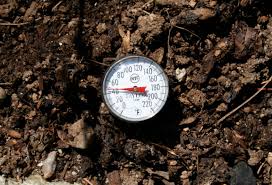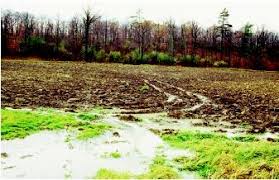The main forces responsible for holding water in the soil are those of capillarity, absorption and osmosis. Capillary forces result from surface tension at the interface between the soil air and soil water.
Molecules in the liquid are attracted more to each other than to the water vapour molecules in the air, resulting in a tendency for the liquid surface to contract.
If the pressure was exactly the same on either side, then the air-water interface would be flat, but pressure differences result in a curved interface, the pressure being greater on the inner, concave side by an amount that is related to the degree of curvature.
At the interface in the soil pore space, the air will be at atmospheric pressure, but the water may be at a lower pressure.
In addition to capillary forces, soil water liquid or vapour can be absorbed upon the surfaces of soil particles mainly due to electrostatic forces in which the polar water molecules are attracted to the charge faces of the solids.
Since the forces involved are only effective very close to the solid surface, only very thin films of water can be held in this way. Nevertheless, if the total surface area of the particles (i.e. the specific surface) is larger, and/or the charge per unit area is large, then the total amount of water absorbed in a volume of soil may be considerable.
A third force which acts to retain water in the soil results from osmotic pressure due to solutes in the soil water. Osmotic pressure is important when there is a difference in solute concentration across a permeable membrane.
This may be at a plant root surface, making water less available to plants, especially in saline soils, or across a diffusion barrier such as an air-filled pore, by allowing the movement of water vapour, but not the solute, across the pore from the more dilute to the more concentrated solution (Hillel, 1982) quoted from (Ward and Robinson, 2000).
The amount of water that can be held in a given volume of soil and the rate of water movement through that soil depend upon both the texture, i.e. the size distribution of the mineral particles of the soil, and upon the soil structure, the aggregation of these particles. Water may occupy both inter structural voids and textural voids (between the particles).
At high moisture contents water flow through the former may be dominant, but becomes rapidly less important as the soil becomes drier. In general, the coarser the particles, the larger will be the intervening voids and the easier it will for water movement to take place.

Thus, sandy soils tend to be more freely draining and permeable than clay soils, which are both slower to absorb water and slower to drain water.
In summary, soil moisture is a critical resource for plant growth as has been established from the above discussions. However, of more importance is capillary water, which is generally accessible to plant roots.
Read Also : Soil Conservation: Meaning, Categories and Soil Management Practices
The knowledge of soil moisture is therefore vital in planning for an effective and efficient irrigation system aimed at improving agricultural productivity.
Soil moisture includes all the water in the zone of aeration, which may extend tens or even hundreds of metres below the ground surface.
Soil moisture is critical for plant growth, and the water accessible to plant is called capillary water. The main forces responsible for holding soil moisture are capillarity, adsorption and osmosis. One of the most popular ways for measuring soil moisture is gravimetric method.

